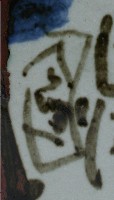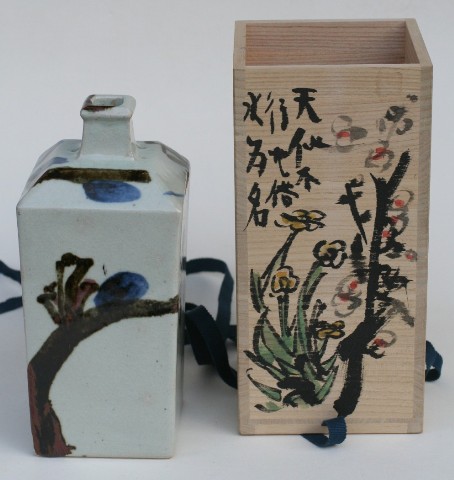Zenga
Hanaire, vase - Haru mata kaeru, spring returnsSigned: Kôshô
Seals:
Technique: Grey Kyoyaki with an underglaze blue and brown iron oxyde decoration 23,6 x 10,3 x 10,3
Box: Signed and decorated
Condition: fine
(from left to right:)
- (“Water immortal” (paper-white). These “immortals” do not wander the world and use “the water” in their name, a paraphrase from the poem Daffodils by the Song poet Yang Wanli (1127-1206).
- All the flowers bloom, thousands at the same time.
- (Sanshi yû, Japanese cornel:) A single branch of sanshi yû of the Bekkabô, a pavilion for a ceremony for monks on February 20-25
- [Daffodil:] Spring returns.
Shimizu Kôshô was born in Himeji. In 1927 he entered the Todai-ji in Nara. Upon graduating in Buddhist studies from Ryokoku University in 1933 he took up residence at the Tenryu-ji for four years to study and practice Zen under the guidance of the Abbot Seki Seisetsu (1877-1945). In 1947 he became director of Todai-ji High School. In 1959 he was appointed director of the Monks' Academy (Kangakuin) at Todai-ji, and in 1963 became director of Todai-ji Girls' School and Todai-ji Kindergarten. 1969 marked a turning point in Kôshô's career, when he was appointed Head of Religious Affairs of the Kegon Tradition. When in 1975 the abbot Kamitsukasa Kaiun (1907-1975) died Kôshô was chosen to be his successor, and he became the 207th abbot of Todai-ji. However, he already resigned in 1981.
For the remaining 18 years of his life, Shimizu Kôshô was dedicated to art. He became a prolific "eccentric" painter, calligrapher and figurative potter. In 1994, when the Shosha Art and Craft Museum (in Himeji, Hyogo Prefecture), was founded, Kôshô was made its honorary director.
Price: ON REQUEST

